
Georgy Sergeevich Zolotarenko, ScDr., professor, was a Russian entomologist specialized in Lepidoptera, mainly Noctuidae: Noctuinae.

Tathorhynchus exsiccata, the Levant blackneck or double-spotted snout, is a moth in the family Erebidae. The species was first described by Julius Lederer in 1855. The nominate form is found on the Canary Islands and in North Africa, tropical Asia and tropical Africa. It has been introduced in Dominica and Argentina. Subspecies Tathorhynchus exsiccata fallax is found in the northern half of Australia, as well as Norfolk Island and New Zealand.
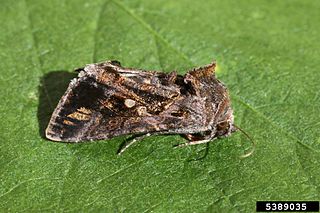
Chrysodeixis includens, the soybean looper, is a moth of the family Noctuidae. It is known as falso medidor in north-eastern Mexico. It is found from southern Quebec and southern Ontario through the eastern and southern part of the United States to Central America and South America, the Antilles and the Galápagos Islands. It is known to be migratory. The species was first described by Francis Walker in 1858.

The peach fruit moth is a species of moth of the Carposinidae family. It is endemic to large parts of Asia, including Japan, Korea, China and Russia. It is an introduced species in Texas, United States.

The dusky cutworm is a moth of the family Noctuidae. It is found from coast to coast from central Canada south to Mexico.

Agrotis fatidica is a moth of the family Noctuidae. It is found in Southern and Central Europe, east through Russia to Mongolia, China and Tibet.
The voluble dart moth is a moth of the family Noctuidae. It is found in North America, from Newfoundland to British Columbia in Canada and in the United States from Maine to Florida and west to the West Coast.

Mocis trifasciata is a moth of the family Erebidae. It is found in the south-west Pacific region, including Samoa, Fiji, Hawaii, New Zealand, the Society Islands and Queensland.
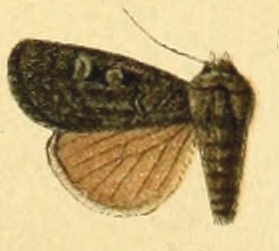
Feltia nigrita is a moth of the family Noctuidae. It is found in Siberia, central Yakutia, the Amur and Primorye regions, as well as British Columbia, Alberta, Saskatchewan, Yukon and Manitoba.
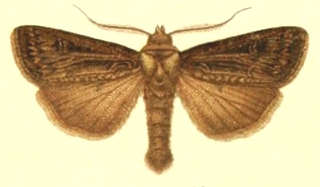
Agrotis trifurca is a moth of the family Noctuidae. It is found in Turkestan, Siberia, south-eastern Ukraine, the Altai Mountains, Tibet, China, Mongolia, the Amur region and the Korean Peninsula. It is also found in the eastern Carpathian Mountains in Romania.

The Siberian cutworm is a moth of the family Noctuidae. It is found from western Siberia to the Amur region. It is also found on the Kuriles and in Sakhalin, Mongolia, western China, Tibet, Afghanistan, Nepal, India, the Korean Peninsula and Japan.

Spodoptera mauritia, the lawn armyworm or paddy swarming caterpillar, is a moth of the family Noctuidae. The species was first described by Jean Baptiste Boisduval in 1833. Able to eat many types of food, it is a major pest throughout the world.
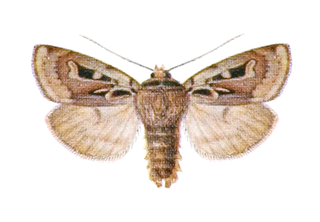
Xestia wockei is a moth of the family Noctuidae. It is known from Siberia and northern North America, including Quebec, Newfoundland and Labrador, the Northwest Territories and Yukon.
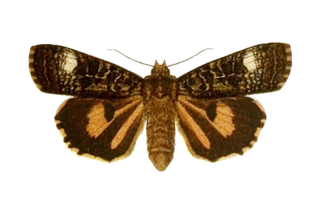
Xestia efflorescens is a moth of the family Noctuidae. It is known from eastern Asia, the Amur Region, Korea and Japan.
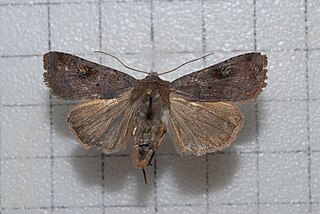
Diarsia canescens is a moth of the family Noctuidae. It is found from southern Siberia and Mongolia to the Ussuri region and Sachalin to the east and from the Kurili Islands through China to the southern Himalayas, Taiwan and northern Indochina to the south. It has recently been recorded from Syria.

Craniophora praeclara is a moth of the family Noctuidae. Its distribution includes North Korea, Japan, China, and the Russian Far East.
Sesamia cretica, the Corn stem borer, Greater sugarcane borer, Sorghum stem borer, Stem corn borer, Durra stem borer, Large corn borer, Pink sugarcane borer, Sugarcane pink borer, Sorghum borer, Pink corn borer, Maize borer or Purple stem borer, is a moth of the family Noctuidae. It was described by Lederer in 1857. It is found in most of the countries and islands of the Mediterranean basin. The range extends through the Middle East and Arabia to Pakistan, northern India and northern Africa. In the south, the range extends to northern Kenya and northern Cameroon.
Choristoneura lafauryana, the strawberry leafroller, is a species of moth of the family Tortricidae. It is found in Spain, Great Britain, the Netherlands, Belgium, France, Germany, Switzerland, Italy, Romania and Russia. In the east, the range extends to China, Korea and Japan.

Haemerosia renalis is a moth of the family Noctuidae. It was described by Jacob Hübner in 1813. It is found in Spain, France, Italy, Sicily, Bosnia and Herzegovina, Serbia, Croatia, Slovenia, Bulgaria, North Macedonia and Greece. It has also been recorded from the Near East.

Earias cupreoviridis, called the cupreous bollworm as a larva, is a moth of the family Nolidae. The species was first described by Francis Walker in 1862. It is found in African countries like Botswana, the Democratic Republic of the Congo, Eritrea, Ethiopia, the Gambia, Kenya, Nigeria, Sierra Leone, South Africa, Togo, Uganda, Zimbabwe to Asian countries like India, Sri Lanka, China, Japan, Korea, Philippines, Indonesia and Hong Kong.
















